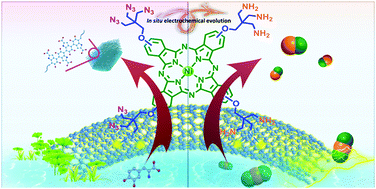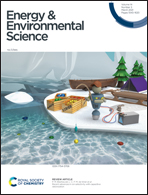Bifunctional single-molecular heterojunction enables completely selective CO2-to-CO conversion integrated with oxidative 3D nano-polymerization†
Abstract
Herein, for the first time, an active and stable bifunctional electrocatalyst has been elaborately designed to achieve the integration of CO2 reduction and anodic non-classical reaction to efficiently yield products of high value at both electrodes, which was constructed by surface anchoring of a novel multi-azido-group-bearing nickel phthalocyanine onto carbon nanotubes at the single-molecule level via strong interactions. Concretely, the obtained heterojunction-type electrocatalyst exhibits ultrahigh activity for completely selective CO2-to-CO conversion with a 100% faradaic efficiency in a wide potential window, large partial current density (>200 mA cm−2) and turnover frequency, and remarkable stability. Particularly, a mass of azido-derived amine groups around the nickel phthalocyanine centers increase the local concentration of CO2via chemisorption, thus boosting the formation of the key intermediate. Unprecedentedly, an exotic electrolytic system integrating CO2 reduction with oxidative nano-polymerization was further conceptually developed using this individual bifunctional electrocatalyst for both the cathode and anode. Besides the high-performance CO2 reduction at the cathode, a unique porous 3D polymer nano-framework was obtained in the anode chamber instead of low-value O2, while the cell voltage was significantly reduced by 1.05 V to achieve 10 mA cm−2.



 Please wait while we load your content...
Please wait while we load your content...